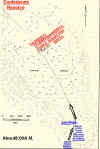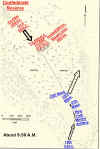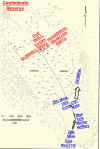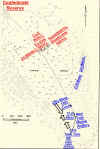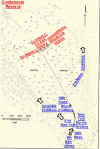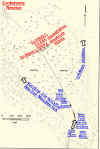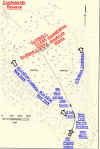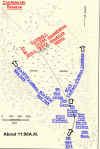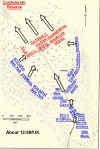The Battle Is Joined
Saturday February 8th, 1862 , dawns overcast as the Federal troops prepare to move out of their temporary encampment at the Hammond House. Burnside and his brigadiers devise a simple order of battle. Foster's brigade will lead the advance, Reno's will follow and Parke will be held in reserve. The lead regiment, Upton's 25th Massachusetts, moves out at approximately 7:30 a.m. Following the 25th is the1st New York Marine Artillery and their battery of boat Howitzers. The road from Ashby's Harbor has turned into mud from the recent rain and the New Yorkers are dragging the guns by hand. As the troops advance they have to wade waist deep through a creek that cuts through the road. Rebel pickets begin to fire on the advancing Yankees. Skirmishers are deployed and the Rebels are pushed back to their main line about a mile away.
As Burnside's troops advance, Confederate Colonel Shaw organizes his troops for a defense. There are too many soldiers to deploy behind the earthwork and its three guns. Most of the Rebel troops are held in reserve 250 yards behind the Confederate line.
The trees and underbrush in front of the battery have been cut down to provide a field of fire of about 300 yards. The area on either flank of the work is thought by the Southerners to be impassible because of the marshy terrain.
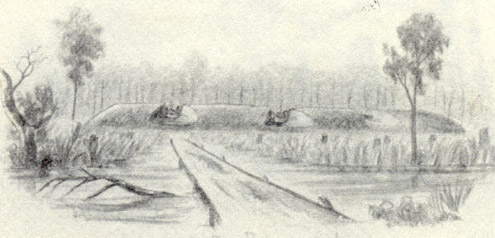
The Rebel earthwork at Suple's Hill sketched by Charles Johnson after the battle. The Yankee troops unofficially called the entrenchment Fort Defiance.
THE UNION ASSAULT
The 25th Massachusetts marches up the road from Ashby's Harbor and emerges into the clearing as the road begins to bear left. Colonel Upton is ordered to protect the Marine battery which is being hauled up the muddy road with the help of sailors from the fleet. With his right wing on the road and left deployed in the swamp, Upton orders the regiment to begin firing on the Confederates. Men sink to their waists in the marshy terrain as they try to find an enemy to fire on.
As the 25th begins the battle, Midshipman Porter commanding the battery of boat howitzers arrives at the bend in the road. Porter positions three guns on firm ground to the right and the three others along the road. The battery commences firing as the Rebel infantry and artillerists turn their attention to the Federal attack. During this early action the battery advances slightly in support of the infantry. Colonel Kurtz's 23rd Massachusetts regiment enters the battlefield and deploys in column of divisions behind the 25th as support. Upton's regiment begins to work it's way forward with Kurtz's still in support
General Foster sees that a frontal assault will not work due to the terrain so he orders the 23rd into the swamp on the right in order to flank the enemy. Kurtz's regiment encounters waist deep water, soft mud and tangling vines as they slowly make their way through the morass once thought impenetrable by the confederate engineers.
Colonel Lee's 27th Massachusetts is the next regiment to enter the fray. They are ordered off the road on the right until the 23rd gets into position. The 23rd uncovers the front of the 27th as the regiment slowly makes it's way towards the Rebel left flank. Lee's 27th is ordered to follow its sister regiment on the right.
Colonel Charles Russell and his 10th Connecticut are next to arrive on the battlefield. The field is crowded with other units as Russell tries to obey General Foster's orders to support the 25th Massachusetts which has maintained it's position. Six companies of the 10th line up behind the 25th while the other four right companies advance to the front and open fire.
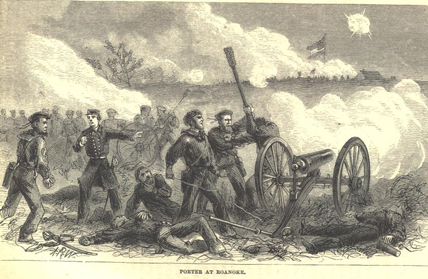
Midshipman Porter and the men of the New York Marine Artillery manning Dahlgren Boat Howitzers fire on the Confederate position.
With Russell's regiment deployed, the way is cleared for Reno's brigade to enter the battle. Reno sees there is no room to deploy his regiments .He determines to flank the Rebel right. The 21st Massachusetts, Reno's first regiment, briefly becomes entangled with the 25th Massachusetts which has expended its ammunition and is retiring from the fight. The 10th Connecticut takes the 25th's place on the firing line.
Colonel Maggi, commanding the 21st, orders his flank companies, armed with Harpers Ferry muskets to advance and engage the enemy while moving to the left. The other eight companies follow closely behind. The 51st New York, commanded by Colonel Ferrero follows the 21st. Four companies of the 51st New York overtake the 21st Massachusetts in the marsh and align themselves on the left of the 21st Massachusetts while the other six companies of the 51st New York take a position on the Massachusetts right.
The 9th New Jersey regiment, with Lieutenant Colonel Heckman commanding, forms behind the 10th Connecticut in a two-company front and opens fire on the Confederates. As the companies run low on ammunition they wheel away and are replaced by two more.
Reno's last regiment, the 51st Pennsylvania, march onto the field shortly after the 9th New Jersey enter the swamp. Colonel Hartranft of the 51st is ordered to the left of the road. The swampy terrain slows the men down, which Reno notices. They are ordered to retrace their steps and move to the right. Eight companies of the regiment overtake the 27th Massachusetts and they become entangled. The other two companies, now separated from their comrades, slowly move back towards the road.
General Parke's brigade acts as a reserve. The 8th Connecticut guards the landing area. The 5th Rhode Island take position at the Ashby house to guard from a flank attack. Colonel Rodman and the 4th Rhode Island lead the 9th New York up the road from the landing area onto the battlefield. Around 11:00 a.m. the 4th is ordered into the swamp on the right of the road. The 24th Massachusetts lands at Ashby's Harbor having been aboard the grounded Guide since yesterday evening.
THE REBEL DEFENSE
The majority of Confederate troops are held in reserve several hundred yards behind the earthwork. There is not enough room on the battle line for all of the troops. Companies B&F of the 31st North Carolina man the earthwork proper. Company B 8th North Carolina defends the right flank. Two company's of the 46th Virginia commanded by Captain's Cole and Wise along with Hasletts Company from the 59th Virginia guard the right flank.
Around 9:30 a.m.. Company's E & K of the 59th Virginia along with Company E of the 8th North Carolina relieve the troops in the breastwork.
The Southern troops maintain their position at the Suple's Hill earthwork as Burnside's troops slowly work their way through the marsh towards the Confederate flanks. The maneuvering Federals have not impressed the defenders this morning. Casualties have thus far been light.
As the battle continues the 2nd North Carolina Battalion arrive on the north end of the island. After distributing ammunition, Colonel Green, commanding the 2nd, orders his men south towards the battle.
The southern line feels increased pressure as the northern troops work their way onto the flanks. Casualties in the southern ranks mount as a result.
Around 10:30 a.m., Company B of the 8th North Carolina refuses it's right to counter the Federal flanking maneuver.
A series of events precipitates a mad dash to the earthwork.
By 11:00 A.M. Reno's brigade on the Union left is in position to outflank the Rebels.
Colonel Shaw has decided the Confederates will retreat from the field.
The 4th Rhode Island have arrived on the field and are ordered into the swamp on the right.
The 9th New York Hawkins Zouaves are behind the Rhode Islanders waiting to join the battle. The Zouaves are ordered to follow the 4th on the right flank. While waiting to enter the swamp, groups of New Yorkers fire on the earthwork.
The 21st Massachusetts along with the four companies of the 51st New York charge the Rebel battery.
General Foster sees Reno's men emerging from the swamp on the left and orders a charge up the road.
Several companies of Zouaves have already entered the swamp behind the 4th Rhode Island. The 9th is ordered to charge the rebel fortifications.
Major Kimball, at the head of the 9th, starts to lead elements of the regiment up the road, the10th Connecticut rise up from a prone position in front of the New Yorkers and fire a volley. The 10th Connecticut are wearing gray overcoats and their sudden appearance startles the Zouaves who discharge their muskets into the backs of the Connecticut men. The gunfire also hits 9th New Jersey troops who are forming up for the charge on the left of the road. The sudden maneuvers panic many New Yorkers who turn back down the road in retreat. The two companies of Pennsylvanians in reserve, along with the 25th Massachusetts, halt the fleeing Zoauves. The reformed 9th heads back up the road towards the Rebel battery and meets Colonel Hawkins just as he emerges from the swamp leading the two companies. Together again, the New Yorkers charge the Rebel entrenchment pell-mell, firing wildly and crying out "Zou! Zou! Zou!" The 21st Massachusetts and the four companies from the 51st New York have already gained the parapet from the Union left when the Zouaves surmount it from the front.
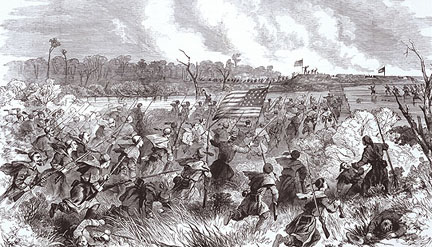
Hawkins Zouaves charge up the road towards the Rebel earthwork at Suple's Hill. Note the Union troops who have already entered the entrenchment on the left.
With the Confederate earthwork vacated, Union troops storm the parapet from three sides. General Burnside has gained his first victory.
The Confederates retreat towards the north end of the island. As word of the defeat reaches the artillerymen in the forts on the island they spike the cannon rendering them inoperable.
Admiral Goldsborough's squadron engaged Fort Bartow around nine a.m.. The Admiral ordered a ceasefire after about half an hour for fear of hitting Federal troops. The sound of battle could clearly be heard aboard ship. Later in the morning Burnside sent a note to Goldsborough requesting the navy not to open fire. Valley City and Louisiana opened fire on the fort around noon and received no reply. Concluding that the fort had been abandoned, a passage is forced through the pilings and obstructions. By nightfall the barrier has been breached in several places.
The victorious Federals reform on the road behind the earthwork. With the main column marching north, The10th Connecticut and 4th Rhode Island go west, enter the abandoned Fort Bartow and raise the American flag. Hawkins' regiment heads east to cut off any retreating Rebels. The 21st Massachusetts meets the 2nd North Carolina Battalion heading south towards the battle field and exchanges fire, killing several North Carolinians. General Foster, at the head of the Federal column, approaches the main Confederate camp at the North end of the island. He orders the 24th Massachusetts to form a battleline. Foster is met by a flag of truce and offers the Confederates only unconditional surrender. After waiting and receiving no reply from Colonel Shaw, Foster orders an advance. Just as the troops start forward, the flag of truce comes back with Shaw's answer in the affirmative.
Over one hundred Rebels escape off the island in small boats and make their way to Nags Head. When word of the defeat reaches the soldiers in Fort Forrest they set fuses to powder charges, blowing up the fort.
The Confederate prisoners are held on the island for two weeks before being paroled in Elizabeth City.
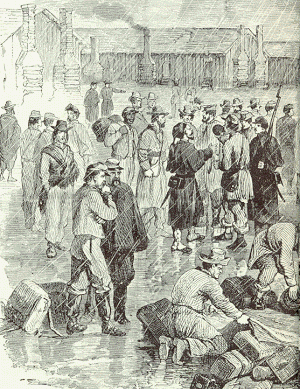
Confederate prisoners mingle with their Union captors in Camp Raleigh after the battle.
The Confederates suffer 246 casualties losing 24 killed in battle. Federals count 35 dead, with wounded and missing the total is 258
.
